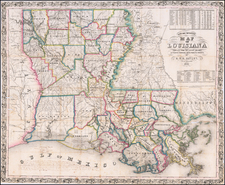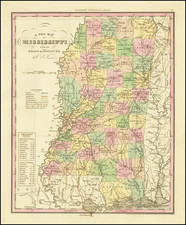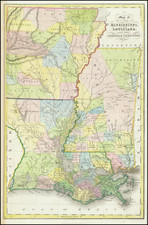The First European Settlement on the Mississippi River
Rare engraved town plan of Natchez (then a part of French Louisiana), by famed French cartographer and spy Victor George Henri Collot. who visited Natchez in October 1796, during his reconnaissance of the Mississippi and Ohio Valleys on behalf of the French Government.
During Collot's stopover in Natchez, he reportedly discovered a British Plot to attack Louisiana from Canada, utilizing a mixed force of whites and Indians, which would come to be known as the Blount Conspiracy. The plan, later discovered by the Americans, was hatched by land speculator and Tennessee Senator William Blount (whose family had acquired millions of acres in Tennessee and the trans-Appalachian west) and his friend, an Indian agent named John Chisholm, who concocted a plan to allow Britain to gain control of Florida and Louisiana, and in return give free access to both New Orleans and the Mississippi River to American merchants. The plan called for territorial militias, with the aid of the British fleet, to attack New Madrid, New Orleans, and Pensacola, in hopes of boosting western land prices.
Established by French colonists in 1716, Natchez is the oldest European settlement on the Mississippi River. In 1716, French explorers established Fort Rosalie high on the bluffs overlooking the Mississippi River. Almost immediately, the Natchez Indians massacred virtually all the settlers, except for a small hunting party. The French militia responded with force, with Natchez Indians in the area either driven away or sold into sugarcane slavery. The area in and around Fort Rosalie became “Natchezm” passing from France to Spain and finally to a fledgling United States.
After the French lost the French and Indian War (Seven Years' War), they ceded Natchez and near territory to Spain in the Treaty of Paris of 1763. (It later traded other territory east of the Mississippi River with Great Britain, which expanded what it called West Florida). After the United States acquired this area from the British after the American Revolutionary War, Natchez served as the first capital of Mississippi Territory (1798) and, later, the state of Mississippi's first capital (1817).
As with most of Collot's maps, this plan pays particular attention to the military structures of settlement and other strategically-relevant landmarks and topography.
Overview of Collot's Spy Mission, Report & Maps
Acting under instructions from Citizen Adet, French Minister to the United States, General George Henri Victor Collot undertook a secret reconnaissance in 1796, of the western American frontier. Collot traveled from Pittsburgh down the Ohio to the Mississippi, up the Mississippi to the Missouri and Illinois Rivers, and then back down the Mississippi to New Orleans. During his journey, he constructed a large number of exceptionally detailed manuscript maps and views of the region that he traversed. Many of these were groundbreaking, containing never before recorded information about a wilderness that was just beginning to undergo settlement.
Completed at nearly the exact time that Lewis & Clark were departing St. Louis, up the Missouri River, Collot's maps were engraved in Paris in 1804, but publication was suppressed due to Napoleon's sale of Louisiana to the United States the previous year. The Louisiana Purchase effectively ended any possibility that the region could be acquired by France. As a result of the changing politics and Collot's death, his report and maps did not come to market until 1826, when they were issued in a limited number under the title Voyage dans l'Amerique Septentrionale . . .
A nineteenth-century bookseller called Collot's work "one of the most famous, most important, and rarest of all books of Mid-Western Explorations." Eberstadt pronounced it "extraordinarily rare." Its rarity is due to the supposed deliberate destruction of all but three hundred French and one hundred English copies by the publisher, who had purchased the edition from Collot's estate, hoping to increase its value.
The Suppression of Collot's Report & Maps
Following his return to France, Collot set out to prepare his report and maps from notes and sketches taken during his journey. In 1800, Napoleon acquired Louisiana from Spain, Collot, and Adet were named two of the commissioners of the new French territory. However, before they could cross the Atlantic to take up their assignments, Napoleon had a change of heart and decided to sell Louisiana to the United States.
Napoleon Bonaparte's decision to sell Louisiana to America brought a practical end to Collot's work on behalf of the French Government. As a result, the impetus to publish Collot's work disappeared and, to the contrary, it became expedient to suppress his reconnaissance, rather than publish its results and overtly admit to the Americans the full scope and extent of Collot's espionage work during his visit.
Ironically, the suppression of Collot's maps has a simultaneous parallel during Thomas Jefferson's administration, when 4 expeditions were sent out by Jefferson to explore the Louisiana Purchase and the Transmississippi West (Lewis & Clark, Zebulon Pike, Dunbar-Hunter and Freeman-Custis expeditions). In April 1806, Thomas Freeman, surveyor, and Dr. Peter Custis, naturalist, undertook an expedition at the request of Thomas Jefferson's administration through parts of Arkansas, Louisiana, Texas, and Oklahoma. They were accompanied by a military escort under the command of Capt. Richard Sparks. At the same time that Zebulon Pike was exploring westward into the Louisiana Territory, Freeman and Custis traveled along the Red River to a site in present-day Texas in the vicinity of the old Caddo villages, where they were stopped by a force of Spanish cavalry protecting the Spanish claims to an ill-defined boundary of the Louisiana Purchase. After a brief skirmish, Freeman and Custis withdrew.
While a report of the 1806 Freeman-Custis expedition was published and a map prepared by Nicholas King, the political sensitivity surrounding the expedition was such that the report of this southern expedition into Texas was kept secret, with only a few copies printed. Nicholas King's map of the expedition, which provided physical proof of the US Government's encroachments into Spanish Texas, was suppressed completely, with no known examples of the map surviving until an example was discovered in about 1877 in the Custis papers and a second example was discovered in the past decade, which had been owned by another early American explorer, Washington Hood (1808-1840).
Georges Henri Victor Collot (1750-1805) was a French soldier, explorer, colonial official, and spy. He served in France’s possessions in North America and the Caribbean. Born in Chalons-sur-Marne in northeastern France in 1750, the young Georges joined the army. He quickly ascended the ranks.
Collot’s first American experience was as a French officer fighting alongside General George Washington in the Revolutionary War. He served as aide-de-camp and maréchal des logis under French general Rochambeau.
From 1792-4, now a Major General, Collot was Governor of Guadeloupe. His time in the Caribbean was short-lived, however, as the British invaded the French colony, imprisoned Collot, and sent him to New York. He evaded punishment and the French turned his presence to their advantage.
Collot was ordered on a reconnaissance mission on the Ohio and Mississippi Rivers. He was to assess the military capacity and fortifications of their imperial rivals, Spain and Britain, as well as to report on the expansion of the Americans westward.
In the spring of 1796, Collot set out. He navigated southward through Illinois and Upper and Lower Louisiana, drawing detailed maps and plans along the way. His presence was not a secret, however; the English, Americans, and Spanish all issued orders to halt his progress. Collot was arrested at Fort Massac on the Ohio River by the American officer Zebulon Pike, but released when Pike found no legal basis for holding him. After reaching the Mississippi, Collot turned upriver to St. Louis, and explored short distances up the Illinois and Missouri rivers as well. While in St. Louis, he may have had access to the maps of the known course of the Missouri River, of Pierre Antoine Soulard, whose maps would later be utilized by Lewis & Clark, as well as access to information from Jean Baptiste Truteau, whose expedition up the Missouri River had just been completed in June 1796.
When Collot arrived in New Orleans in October of 1796, the Spanish Governor, Carondelet, seized Collot and his maps. He was released in early December and returned to France.
Changing imperial politics delayed the publication of Collot’s account of his voyage until 1805. He died in the same year. At the time of his death, his spy mission was little known. It was only in 1826 that a limited reissue of his account was published by Arthus Bertrand. He printed 300 French copies and 100 English; Bertrand destroyed the surviving 1805 examples.
Collot’s maps and plans are superbly rendered cartographic works detailing the contested Mississippi and Ohio River Valleys and they remain very scarce today.









![[Florida and Gulf Coast] The Coast of West Florida and Louisiana . . . [with] The Peninsula and Gulf of Florida or Channel of Bahama with the Bahama Islands . . .](https://storage.googleapis.com/raremaps/img/small/66344.jpg)




![[ Map of the Mississippi River ]](https://storage.googleapis.com/raremaps/img/small/99811.jpg)